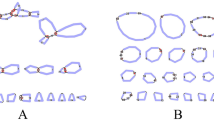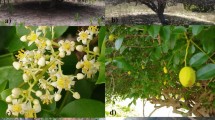Abstract
In an effort to gain greater insight into the nature of the population genetic structure of the pest insect Spodoptera litura (Lepidoptera: Noctuidae), tobacco cutworms were collected from six Korean and five Chinese localities, and their mitochondrial A+T-rich region and nuclear internal transcribed spacer 2 (ITS2) were cloned and sequenced. The A+T-rich region and nuclear ITS2 provided a maximum sequence divergence of 2.88 and 1.82%, respectively. Overall, a low level of genetic fixation (F ST = 0–0.02965 in the A+T-rich region and 0–0.34491 in ITS2) and no discernible isolated population were noted among most S. litura populations. Along with these results, the absence of genetic variance between Korea and China indicates a profound interrelation of the S. litura populations in the two countries, consistent with the current notion that S. litura has sufficient flight capacity for dispersal.



Similar content being viewed by others
References
Anderson SJ, Conrad KF, Gillman MP, Woiwod IP, Freeland JR (2008) Phenotypic changes and reduced genetic diversity have accompanied the rapid decline of the garden tiger moth (Arctia caja) in the UK. Ecol Entomol 33:638–645
Arnheim N (1983) Concerted evolution of multigene families. In: Kohen R, Nei M (eds) Evolution of genes and proteins. Sinauer Associates, Sunderland
Avise JC (1989) Gene trees and organismal histories: a phylogenetic approach to population biology. Evolution 43:1191–1208
Avise JC, Neigel JE, Arnold J (1987) Intraspecific phylogeography: the mitochondrial DNA bridge between population genetics and systematics. Ann Rev Ecol Syst 18:489–522
Bae SD, Park KB (1999) Effects of temperature and food source on pupal development, adult longevity and oviposition of the tobacco cutworm, Spodoptera litura Fabricius. Korean J App Entomol 38:23–28
Birky CW Jr, Maruyama T, Fuerst P (1983) An approach to population and evolutionary genetic theory for genes in mitochondria and chloroplasts, and some results. Genetics 103:513–527
Brattström O, Åkesson S, Bensch S (2010) AFLP reveals cryptic population structure in migratory European red admirals (Vanessa atalanta). Ecol Entomol 35:248–252
Bravo JP, Felipes J, Zanatta DB, Silva JLC, Fernandez MA (2008) Sequence and analysis of the mitochondrial DNA control region in the sugarcane borer Diatraea saccharalis (Lepidoptera: Crambidae). Braz Arch Biol Technol 51:671–677
Cameron SL, Whiting MF (2008) The complete mitochondrial genome of the tobacco hornworm, Manduca sexta (Insecta: Lepidoptera: Sphingidae), and an examination of mitochondrial gene variability within butterflies and moths. Gene 408:112–123
Castresana J (2000) Selection of conserved blocks from multiple alignments for their use in phylogenetic analysis. Mol Biol Evol 17:540–552
Clark PL, Molina-Ochoa J, Martinelli S, Skoda SR, Isenhour DJ, Lee DJ, Krumm JT, Foster JE (2007) Population variation of the fall armyworm, Spodoptera frugiperda, in the Western Hemisphere. J Insect Sci 5:1–10
Cochran WW, Mouritsen H, Wikelski M (2004) Migrating songbirds recalibrate their magnetic compass daily from twilight cues. Science 304:405–408
Depaquit J, Lienard E, Verzeaux-Griffon A, Ferté H, Bounamous A, Gantier JC, Hanafi HA, Jacobson RL, Maroli M, Moin-Vaziri V, Müller F, Ozbel Y, Svobodova M, Volf P, Léger N (2008) Molecular homogeneity in diverse geographical populations of Phlebotomus papatasi (Diptera, Psychodidae) inferred from ND4 mtDNA and ITS2 rDNA epidemiological consequences. Infect Genet Evol 8:159–170
Dingle H (1996) Migration: the biology of life on the move. Oxford University Press, Oxford
Drake VA, Gregg PC, Harman IT, Wang HK, Deveson ED, Hunter DM, Rocbester WA (2001) Characterizing insect migration systems in inland Australia with novel and traditional methodologies. In: Woiwod IP, Reynolds DR, Thomas CD (eds) Insect movement: mechanisms and consequences. CABI, Wallingford, pp 207–233
Excoffier L, Smouse PE, Quattiro JM (1992) Analysis of molecular variance inferred from matrix distances among DNA haplotypes: application to human mitochondrial DNA restriction data. Genetics 131:479–491
Excoffier L, Laval G, Schneider S (2005) Arlequin version 3.0: an integrated software package for population genetics data analysis. Evol Bioinf Online 1:47–50
Felsenstein J (1985) Confidence limits on phylogenies: an approach using the bootstrap. Evolution 39:783–791
Fitch WM (1971) Toward defining the course of evolution: minimal change for a specific tree topology. Syst Zool 20:406–416
Folmer O, Black M, Hoeh W, Lutz R, Vrijenhoek R (1994) DNA primers for amplification of mitochondrial cytochrome c oxidase subunit I from diverse metazoan invertebrates. Mol Mar Biol Biotechnol 3:294–299
Gatehouse AG (1997) Behavior and ecological genetics of wind-borne migration of insects. Annu Rev Entomol 42:475–502
Grapputo A, Kumpulainen T, Mappes J, Parri S (2005) Genetic diversity in populations of asexual and sexual bag worm moths (Lepidoptera: Psychidae). BMC Ecol 5:5
Hamarsheh O, Presber W, Al-Jawabreh A, Abdeen Z, Amor A, Schönian G (2009) Molecular markers for Phlebotomus papatasi (Diptera: Psychodidae) and their usefulness for population genetic analysis. Trans R Soc Trop Med Hyg 103:1085–1086
Hartl DL, Clark AG (1989) Principles of population genetics. Sinauer Associates, Sunderland
Hill JK, Gatehouse AG (1992) Genetic control of the pre-reproductive period in Autographa gamma (L.) (Silver Y moth) (Lepidoptera: Noctuidae). Heredity 69:458–464
Holland RA, Wikelski M, Wilcove DS (2006) How and why do insects migrate? Science 313:794–796
Ji Y, Zhang D, He L (2003) Evolutionary conservation and versatility of a new set of primers for amplifying the ribosomal internal transcribed spacer regions in insects and other invertebrates. Mol Ecol Notes 3:581–585
Katoh K, Misawa K, Kuma K, Miyata T (2002) MAFFT: a novel method for rapid multiple sequence alignment based on fast Fourier transform. Nucleic Acids Res 30:3059–3066
Keller A, Schleicher T, Schultz J, Müller T, Dandekar T, Wolf M (2009) 5.8S–28S rRNA interaction and HMM-based ITS2 annotation. Gene 430:50–57
Kim I, Lee EM, Seol KY, Yun EY, Lee YB, Hwang JS (2006) The mitochondrial genome of the Korean hairstreak, Coreana raphaelis (Lepidoptera: Lycaenidae). Insect Mol Biol 2:217–225
Kim I, Cha SY, Kim MA, Lee YS, Lee KS, Choi YS, Hwang JS, Jin BR, Han YS (2007) Polymorphism and genomic structure of the A+T-rich region of mitochondrial DNA in the oriental mole cricket, Gryllotalpa orientalis (Orthoptera: Gryllotalpidae). Biochem Genet 45:589–610
Kim MJ, Kim MI, Wan XL, Kim KG, Kim I (2010) Complete nucleotide sequence and organization of the mitogenome of the endangered Eumenis autonoe (Lepidoptera: Nymphalidae). Afr J Biotechnol 9:735–754
Kimura M (1980) A simple method for estimating evolutionary rate of base substitution through comparative studies of nucleotide sequences. J Mol Evol 16:111–120
Kiritani K (1984) Colonizing insects: what prevented the brown planthopper from establishing itself in Japan? Insectarium 21:136–143
Knipling EF (1980) Regional management of the fall armyworm: a realistic approach? Fla Entomol 63:468–480
Lee ES, Shin KS, Kim MS, Park H, Cho S, Kim CB (2006) The mitochondrial genome of the smaller tea tortrix Adoxophyes honmai (Lepidoptera: Tortricidae). Gene 373:52–57
Lewter JA, Szalanski AL, Nagoshi RN, Meagher RL, Owens CB, Luttrell RG (2006) Genetic variation within and between strains of the fall armyworms, Spodoptera frugiperda (Lepidoptera: Noctuidae). Fla Entomol 89:63–68
Liu Y, Li Y, Pan M, Dai F, Zhu X, Lu C (2008) The complete mitochondrial genome of the Chinese oak silkmoth, Antheraea pernyi (Lepidoptera: Saturniidae). Acta Biochim Biophys Sin 8:693–704
Lohman DJ, Peggie D, Pierce NE, Meier R (2008) Phylogeography and genetic diversity of a widespread Old World butterfly, Lampides boeticus (Lepidoptera: Lycaenidae). BMC Evol Biol 8:301
Lukoschek V, Waycott M, Keogh JS (2008) Relative information content of polymorphic microsatellites and mitochondrial DNA for inferring dispersal and population genetic structure in the olive sea snake, Aipysurus laevis. Mol Ecol 17:3062–3077
Meraner A, Brandstätter A, Thaler R, Aray B, Unterlechner M, Niederstätter H, Parson W, Zelger R, Dalla Via J, Dallinger R (2008) Molecular phylogeny and population structure of the codling moth (Cydia pomonella) in central Europe: I. Ancient clade splitting revealed by mitochondrial haplotype markers. Mol Phylogenet Evol 48:825–837
Miller BR, Crabtree MB, Savage H (1996) Phylogeny of fourteen Culex mosquito species including the Culex pipines complex, inferred from the internal transcribed spacer of ribosomal DNA. Insect Mol Biol 5:93–107
Murata M (2001) Research on long-distance migration of the common cutworm, Spodoptera litura. PhD dissertation United Graduate School of Agriculture, Kagoshima University, Kagoshima
Murata M, Etoh T, Itoyama K, Tojo S (1998) Sudden occurrence of the common cutworm, Spodoptera litura (Lepidoptera: Noctuidae) in Southern Japan during typhoon season. Appl Entomol Zool 28:291–301
Neog K, Singh HR, Unni B, Sahu AK (2010) Analysis of genetic diversity of muga silkworm (Antheraea assamensis, Helfer; Lepidoptera: Saturniidae) using RAPD-based molecular markers. Afr J Biotechnol 9:1746–1752
Pashley DP, Johnson SJ (1986) Genetic population structure of migratory moths: the velvetbean caterpillar (Lepidoptera: Noctuidae). Ann Entomol Soc Am 79:26–30
Roderick GK (1996) Geographic structure of insect population: gene flow, phylogeography, and their uses. Annu Rev Entomol 41:263–290
Saito O (2000) Flight activity of three Spodoptera spp., Spodoptera litura, S. exigua and S. depravata, measured by flight actograph. Physiol Entomol 25:115–124
Salvato P, Battisti A, Concato S, Masutti L, Patarnello T, Zane L (2002) Genetic differentiation in the winter pine processionary moth (Thaumetopoea pityocampa–wilkinsoni complex) inferred by AFLP and mitochondrial DNA markers. Mol Ecol 11:2435–2444
Sezonlin M, Dupas S, Le Rü B, Le Gall P, Moyal P, Calatayud PA (2006) Phylogeography and population genetics of the maize stalk borer Busseola fusca (Lepidoptera, Noctuidae) in sub-Saharan Africa. Mol Ecol 15:407–420
Shapiro LH, Scheeffer SJ, Maisin N, Lambert S, Purung HB, Sulistyowati E, Vega FE, Gende P, Laup S, Rosmana A, Djam S, Hebbar PK (2008) Conopomorpha cramerella (Lepidoptera: Gracillariidae) in the Malay Archipelago: genetic signature of a bottlenecked population? Ann Entomol Soc Am 101:930–938
Sosa-Gómez DR (2004) Intraspecific variation and population structure of the velvetbean caterpillar Anticarsia gemmatalis Hübner, 1818 (Insecta: Lepidoptera: Noctuidae). Genet Mol Biol 27:378–384
Swofford DL (2002) PAUP: phylogenetic analysis using parsimony (and other methods) version 4.10. Sinauer Associates, Sunderland
Tamura K (1992) Estimation of the number of nucleotide substitutions when there are strong transition-transversion and G+C content biases. Mol Biol Evol 9:678–687
Tang L, Xu S, Yi M, Li G, Zheng C (2009) Occurrence characteristics and integrated control method of Spodoptera litura in the main Colocasia esculenta producing areas of Guangdong. Guangdong Agri Sci 7:116–118
Taylor MFJ, McKechnie SW, Pierce N, Kreitman M (1993) The lepidopteran mitochondrial control region: structure and evolution. Mol Biol Evol 10:1259–1272
Thomas MJ, Jacob A, Nair MRGK (1969) Host-biology relations of Spodoptera litura (F.) (Lepidoptera: Noctuidae). Indian J Agri Sci 39:400–402
Tojo S, Mishima H, Kamiwada H, Ngakan PO, Chang WS (2008) Variations in the occurrence patterns of male moths of the common cutworm, Spodoptera litura (Lepidoptera: Noctuidae) among Southeastern Asian countries, as detected by sex pheromone trapping. Jpn J App Entomol Zool 43:569–576
Tu YG, Wu KM, Xue FS, Lu YH (2010) Laboratory evaluation of flight activity of the common cutworm, Spodoptera litura (Lepidoptera: Noctuidae). Insect Sci 17:53–59
Vandewoestijne S, Baguette M, Brakefield PM, Saccheri IJ (2004) Phylogeography of Aglais urticae (Lepidoptera) based on DNA sequences of the mitochondrial COI gene and control region. Mol Phylogenet Evol 31:630–646
Wan P, Wu K, Huang M, Yu D, Wu J (2008) Population dynamics of Spodoptera litura (Lepidoptera: Noctuidae) on Bt cotton in the Yangtze River Valley of China. Environ Entomol 37:1043–1048
Wilson K, Gatehouse AG (1992) Migration and genetics of pre-reproductive period in the moth, Spodoptera exempta (African armyworm). Heredity 69:255–262
Yukuhiro K, Sezutsu H, Itoh M, Shimizu K, Banno Y (2002) Significant levels of sequence divergence and gene rearrangements have occurred between the mitochondrial genomes of the wild mulberry silkmoth, Bombyx mandarina, and its close relative, the domesticated silkmoth, Bombyx mori. Mol Biol Evol 8:1385–1389
Acknowledgment
This study was supported by a grant from the Agenda Program (no. 200901FHT020609413) from the Rural Development Administration, Republic of Korea.
Author information
Authors and Affiliations
Corresponding author
Rights and permissions
About this article
Cite this article
Wan, X., Li, J., Kim, M.J. et al. DNA Sequence Variation of the Tobacco Cutworm, Spodoptera litura (Lepidoptera: Noctuidae), Determined by Mitochondrial A+T-rich Region and Nuclear ITS2 Sequences. Biochem Genet 49, 760–787 (2011). https://doi.org/10.1007/s10528-011-9449-1
Received:
Accepted:
Published:
Issue Date:
DOI: https://doi.org/10.1007/s10528-011-9449-1




